This is the trailer for Chocolate, from Prachya Pinkaew, director of Ong-bak and The Protector, which made a super-star of Tony Jaa. It’s about an autistic girl who picks up martial-arts skills from TV and their next-door neighbours, a muay thai academy. She uses those skills to collect debts on behalf of her ill mother, which incurs the wrath of both local and Japanese gangs. As with Pinkaew’s earlier films, there is no wire-work or CGI – it’s all raw, athletic ability, and based on this trailer alone (or even the painful out-takes), it could be the best action heroine film of 2008. The Thai release is February 8.
Author: Jim McLennan
The Angelmakers
★★★
“When the Blue Danube turned red…”
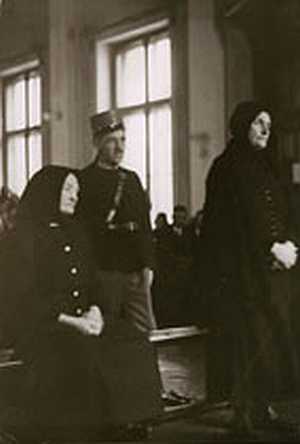 You wouldn’t know it to look at the sleepy Hungarian village of Nagyrév [population: 872], but there was a time between the world wars when this was the murder capital of the world. Between 1914 and 1929, an estimated three hundred people were poisoned to death, using arsenic obtained by boiling down flypaper. The great majority of the murders were committed by local women, who wanted rid of their husbands; the local midwife, Julia Fazekas, was the source of the lethal materials. This was in an era when divorce was all but impossible, and many marriages were arranged; Julia offered a quick and painless (for the wife!) escape from a life of abuse and a loveless relationship. Since she was the closest the village had to a doctor, and her cousin was in charge of filing the death certificates, she and her accomplices got away with their crimes.
You wouldn’t know it to look at the sleepy Hungarian village of Nagyrév [population: 872], but there was a time between the world wars when this was the murder capital of the world. Between 1914 and 1929, an estimated three hundred people were poisoned to death, using arsenic obtained by boiling down flypaper. The great majority of the murders were committed by local women, who wanted rid of their husbands; the local midwife, Julia Fazekas, was the source of the lethal materials. This was in an era when divorce was all but impossible, and many marriages were arranged; Julia offered a quick and painless (for the wife!) escape from a life of abuse and a loveless relationship. Since she was the closest the village had to a doctor, and her cousin was in charge of filing the death certificates, she and her accomplices got away with their crimes.
All good things must come to an end, however. It’s unclear what triggered police action, but Fazekas knew the game was up, and by the time the police knocked on her door, she’d used her own poison to commit suicide. 26 of her associates, however, were taken to court; eight were sentenced to death, seven to life imprisonment and the remainder to various terms in jail. Eight decades later, Bussink returned to the village, and found some inhabitants still alive, who were around at the time, such as the 93-year old Rosika, in whose pantry one of the murderers hung herself from a nail. Her family then used the nail to hang bacon up.
It’s an not uncommon moment of gallows humour in the film (which puts the death-toll lower, at “only” 140). While Bussink initially met some resistance from the locals, they seem happy here to open up to her; the women, in particular, view past events with phlegmatic resignation. Maybe there’s something about Hungarian ladies; see also Vera Renczi, who murdered 35, including husbands, lovers, and a son early in the twentieth century, and of course, Countess Erzsebet Bathory. However, the film never really does more than scratch the surface, and the running-time is padded unnecessarily by shots of the local countryside, rather than providing more historical background. There’s a pointed, if very clumsy, allusion to modern times, with a local folk-dance club discussing the problems they have with their husbands.
The overall effect is to open the door on a largely-forgotten corner of murderous history, but Bussink doesn’t shine much light into the dark corner. There was word of a movie based on the topic, to star Helen Mirren, which shifted the location from Hungary to Yorkshire, with Anna Friel and John Hurt also involved, and Jon Sommersby Amiel as the director. [Curiously, Friel recently played Countess Bathory in another film] That was first announced in August 2006, but IMDB still shows it as “in development”, so who knows. I suspect the Hollywood fantasy will be nowhere near as bleakly murderous as the reality, somehow.
Biohazards
★★★
 If you thought the novel was a quick read, I got through Biohazards during lunch, and that’s only with 30 minutes. Still, being a comic-book, we must cut it some slack, though I can’t say I find action (and there’s a lot of it here) is something that works very well in panel form, lacking the true sense of motion you get in cinema. That said, I still didn’t hate this first entry in the trans-Pacific entry, in which Kei and Yuri are sent to investigate the kidnapping of an industrialist’s mind by his rival [literally: it’s on a chip]. Adding a little spice, both companies are knee-deep in dubious bioweapons, so who is the real villain here?
If you thought the novel was a quick read, I got through Biohazards during lunch, and that’s only with 30 minutes. Still, being a comic-book, we must cut it some slack, though I can’t say I find action (and there’s a lot of it here) is something that works very well in panel form, lacking the true sense of motion you get in cinema. That said, I still didn’t hate this first entry in the trans-Pacific entry, in which Kei and Yuri are sent to investigate the kidnapping of an industrialist’s mind by his rival [literally: it’s on a chip]. Adding a little spice, both companies are knee-deep in dubious bioweapons, so who is the real villain here?
It’s another different style, in some ways perhaps more Japanese than classic DP, though still with something alien to it, as if the artist had learned from one of those “Draw Manga” books. Which is less a knock on Warren than it probably sounds, being more an acknowledgement of how influential the Dirty Pair comics are [there was a time when manga was not to be found in Borders, y’know]. The in-jokes are actually more restrained than I remembered – and expected, after the very first page has a security guard singing the theme to Magnum of Love’s Destiny, a movie from the City Hunter series. But that was about it, unless “Power up the synthesizer, Neil” is a Rush reference? Hard to be sure…
There are some interesting nods to the original novels, such as Mughi’s ability to manipulate the electromagnetic spectrum, and Yuri’s Bloody Card weapon is almost exactly as described in Great Adventures. That may be the weakness here, in that Warren and Smith seem less intent on bringing anything new to the characters, than being faithful to the original texts. As the series progresses, however, that would become less of an issue, but while the first, this is certainly not the best, or most representative, of the US comics.
Story: Toren Smith and Adam Warren
Art: Adam Warren
The Blackburn & Scarletti Mysteries, Volume II, by Karen Koehler
★★★
“Truly a book of two halves, Brian.”
 Coincidentally, a year after the first collection, I find the time to read volume two; this contains two stories rather than two-and-a-fragment, but weighs in at about forty pages or so longer. Same price though, I am pleased to note… The first, Legion, takes our FBI agent and her semi-vampiric colleagues off to the post-flood city of New Orleans where a demonic force has been unleashed, which is capable of transferring its presence from one body to another. Hmmm…sounds not unlike Fallen, perhaps? That aside, I did enjoy this one thoroughly: the pace is good and, if the eventual destination of the entity is not perhaps a surprise (it’s quite close to the pair, shall we say), it makes for some great set-pieces. The best of these involves a church where the possessed victim is resting up, which results in a hellacious battle that’s genuinely exciting. The story elements are tidied up nicely too, leaving this a self-contained and effective tale.
Coincidentally, a year after the first collection, I find the time to read volume two; this contains two stories rather than two-and-a-fragment, but weighs in at about forty pages or so longer. Same price though, I am pleased to note… The first, Legion, takes our FBI agent and her semi-vampiric colleagues off to the post-flood city of New Orleans where a demonic force has been unleashed, which is capable of transferring its presence from one body to another. Hmmm…sounds not unlike Fallen, perhaps? That aside, I did enjoy this one thoroughly: the pace is good and, if the eventual destination of the entity is not perhaps a surprise (it’s quite close to the pair, shall we say), it makes for some great set-pieces. The best of these involves a church where the possessed victim is resting up, which results in a hellacious battle that’s genuinely exciting. The story elements are tidied up nicely too, leaving this a self-contained and effective tale.
However, despite the second story possessing a great title – The Phantom of the Soap Opera – I was much less engaged by it. The set of a daytime TV drama is plagued by mysterious ‘accidents’ of an occult nature, which leads to the pair re-uniting in order to investigate, triggered by a call from an old friend of Scarletti’s. There is just not enough meat on the bones of this one, though perhaps Koehler wasn’t happy with it either, since there is a lot of back-story added here. Indeed, to such a degree that it burdens the main characters, and its relevance to the main plot is doubtful. I’m also growing rather disillusioned by Blackburn’s relationship to the Jackal, the full vampire who saved her life in volume one; Koehler is treading dangerously close here, to the cliches which eventually sank the Anita Blake series.
Another small peeve was a surprising number of typos in the volume, such as “a traveling bad slung over one shoulder.” Though I’m far from immune to these myself [even if you can only have the ‘u’ in ‘colour’ when you pry it from my cold, dead hands, dammit], and I did smile at one, when Blackburn was served by a “gun-chewing waitress.” I’d be sure to leave her a good tip. Overall, not quite as good as the first compilation, though that’s largely down to the second story – individually, Legion rates a ****, but Phantom only **, getting stuck in a morass of its own making. While that leaves the review ending on a disappointing note, Blackburn remains an engaging heroine, and if Koehler can get back to more action-oriented writing in the next volume (as she showed herself eminently capable of in Legion), I’ll be waiting eagerly.
Hard Candy
★★★★
“More threatening than girls with guns: teenage girls with scalpels. Gentlemen: cross your legs.”

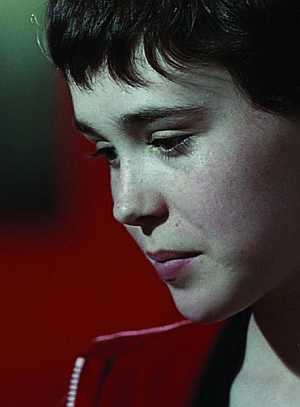 This is almost unbearably creepy, in two different directions: however, it’s almost impossible to discuss this film in any meaningful way without spoilers, so you have been warned. The danger of online predators is well-known, and when fourteen-year old Hayley (Page) agrees to meet photographer Jeff (Wilson), who is in his thirties, alarm bells are ringing. They reach a piercing level after she goes to his house, starts drinking vodka and flirting outrageously. However, the tables are abruptly turned: she’s spiked Jeff’s drink, and he wakes to find himself tied-up, and entirely at Hayley’s mercy. He soon finds out that’s a quality she is very definitely not inclined to provide.
This is almost unbearably creepy, in two different directions: however, it’s almost impossible to discuss this film in any meaningful way without spoilers, so you have been warned. The danger of online predators is well-known, and when fourteen-year old Hayley (Page) agrees to meet photographer Jeff (Wilson), who is in his thirties, alarm bells are ringing. They reach a piercing level after she goes to his house, starts drinking vodka and flirting outrageously. However, the tables are abruptly turned: she’s spiked Jeff’s drink, and he wakes to find himself tied-up, and entirely at Hayley’s mercy. He soon finds out that’s a quality she is very definitely not inclined to provide.
So, who do we sympathize with? The paedophile? Or the psychopath? Pick your poison, and it’s the kind of bravely ambivalent film I love, for Jeff is far from the usual cliched portrayal of a child-molester: rather than a sleazy old man in a dirty mac, he’s charming, well-spoken and educated. Which makes him far more dangerous, of course. Though he meets his match in Hayley, and it’s a brilliant performance by Page. We have absolutely no idea whether any of what she says is true, regarding herself (is she 14, or is that part of her act?), her family or even the apparently-damning evidence she finds of Jeff’s paedophile tendencies. The last is perhaps an error on the film’s part, since it’s at its best when we’re less certain as to whether Jeff deserves the horrible fate Hayley has in store.
Oh, yes: horrible. Armed only with a medical textbook, a bag of ice and some sharp objects, she prepares to make sure that Jeff will not bother any other little girls again. Cue the film’s second, and most critical, mis-step, as it pulls a punch which would have made this an instant evil classic – you sense Takashi Miike, whose Audition this most closely resembles, might not have backed off. From here, the film does stray into implausible territory, with Jeff spurning several chances to escape, or overpower Hayley [who looks about 95 pounds]. However, that doesn’t really diminish from a film that has the guts to ask a lot of questions which seem to have easy answers, and then confront us with a reality that makes things more complex than we’d wish.
Dir: David Slade
Star: Ellen Page, Patrick Wilson
Lady Gangster
★★★
“An archetypal forties B-movie; a straightforward tale, briskly told.”
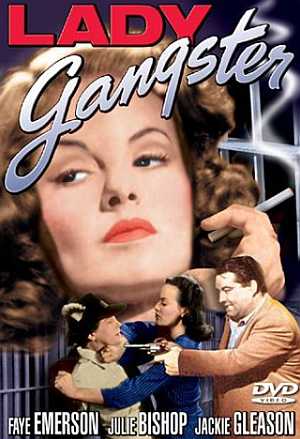 Having watched both Transformers and Miami Vice over the past week, it’s nice to see a film that doesn’t hang around: coming in at sixty-two minutes, Lady Gangster has hardly a line of dialogue that does not propel the story forward. Based on the play, Ladies They Talk About (previously a 1933 film starring Barbara Stanwyck), this centers on Dorothy Burton, member of a gang of bank-robbers. She takes the rap for one of their jobs, and goes to jail, but is also the only one who knows where the loot is hidden. Childhood friend Kenneth Phillips (Wilcox), now a renowned broadcaster, tries to help Dorothy get parole, but she has also made an enemy inside the prison, who is just as keen our heroine does not get released, and her former gang colleagues have their own interests, needless to say.
Having watched both Transformers and Miami Vice over the past week, it’s nice to see a film that doesn’t hang around: coming in at sixty-two minutes, Lady Gangster has hardly a line of dialogue that does not propel the story forward. Based on the play, Ladies They Talk About (previously a 1933 film starring Barbara Stanwyck), this centers on Dorothy Burton, member of a gang of bank-robbers. She takes the rap for one of their jobs, and goes to jail, but is also the only one who knows where the loot is hidden. Childhood friend Kenneth Phillips (Wilcox), now a renowned broadcaster, tries to help Dorothy get parole, but she has also made an enemy inside the prison, who is just as keen our heroine does not get released, and her former gang colleagues have their own interests, needless to say.
Made in 1942, there really weren’t very many films of that period which features female protagonists in this kind of role, and it deserves credit for that. The first half, in particular, is remarkably watchable today, though the plot does find itself badly-convoluted later on. There’s a lot to get through, and the film gallops on at such a heady pace, it feels almost like a trailer for itself. Made post-Hays Code, that obviously forced the makers to tone things down as far as content goes; despite the head warden’s protests that the jail is “neither a country club nor a concentration camp”, it’s certainly closer to the former. Emerson is great as the heroine – she’d go on to a long television career – and Jackie Gleason (The Honeymooners) also turns up as the gang’s getaway driver. Despite a daring escape from jail, she ends up taking a back-seat to Phillips and his two-fisted heroics at the finale, which is something of a shame, but undoubtedly a result of the era. Certainly remains a decent effort.
Dir: “Florian Roberts” [real name: Robert Florey]
Star: Faye Emerson, Frank Wilcox, Julie Bishop, Roland Drew
Rosario Tijeras
★★★
“The film that could only be made in South America – where life is…very, very grim.”
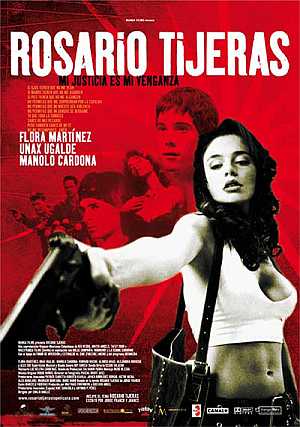 Antonio (Ugalde) and Emilio (Cardona) meet the gorgeous Rosario (Martinez) at a nightclub in Medellin, Columbia, and both form a relationship with her – Emilio, a physical one; Antonio, a platonic but perhaps more deeply felt attachment. While information on Rosario is limited, not least from herself, they soon discover that she has a dark past (Tijeras isn’t her surname, it’s Spanish for “scissors”. Let’s leave it at that, shall we?) and a dark present (among the many rumour swirling around is that she has killed 200 or more, in her role as a hitwoman for the local drug cartels). Nor is the forecast for her future sunshine and rainbows, since the first scene has Antonio carrying a badly shot-up Rosario into a local hospital, with the rest of the film told in a series of flashbacks.
Antonio (Ugalde) and Emilio (Cardona) meet the gorgeous Rosario (Martinez) at a nightclub in Medellin, Columbia, and both form a relationship with her – Emilio, a physical one; Antonio, a platonic but perhaps more deeply felt attachment. While information on Rosario is limited, not least from herself, they soon discover that she has a dark past (Tijeras isn’t her surname, it’s Spanish for “scissors”. Let’s leave it at that, shall we?) and a dark present (among the many rumour swirling around is that she has killed 200 or more, in her role as a hitwoman for the local drug cartels). Nor is the forecast for her future sunshine and rainbows, since the first scene has Antonio carrying a badly shot-up Rosario into a local hospital, with the rest of the film told in a series of flashbacks.
Medellin used to be a credible contender as murder capital of the world. During 1991, this city of about two million people saw over seven thousand homicides – there were less than seven hundred in all of England and Wales the same year. That may go some way to explaining the casual approach towards live, love and death shown by most of the characters here; why think about tomorrow when it might not arrive? Rosario’s job is more hinted at than actually depicted: while we do see her kill a couple of people, it’s far more for personal reasons, and despite the cover, this is less an action film than heavily-armed drama.
It’s a good performance from Martinez, however, and the hidden aspects of her character pull you in, to see what’s going to be revealed. Make no mistake though; this is downbeat material, through and through, with an unexpected cameo by Alex Cox [director of Repo Man] one of the few lighter moments. Otherwise, if you can think of something bad that might happen, odds are it will. Rosario’s psychology is also a little too conveniently pat – it was absolutely no surprise to discover she was abused as a child, even if the gap between that and mob killer seems to require more explanation. On the whole, this is solid and worthy, though it’d be something of a stretch to describe it as entertaining.
Dir: Emilio Maillé
Star: Flora Martínez, Manolo Cardona, Unax Ugalde
Hood Angels
★½
“You’ll be a right Charlie if you bother with this one…”
 I think I can safely say that this films fails miserably on just about every level. Now, I am probably not the target audience for this unashamedly ‘urban’ movie, but that didn’t stop me from enjoying the works of Pam Grier. This, on the other hand… Three women (Brown, Nurse and Sha – though I’ve my suspicions that one of them might just be a man) are arrested under dubious circumstances, but are bailed out to investigate the murder of one’s brother, a rising rapper. They get employed at his record-label, the questionably-spelled Murda Boi records, to scope out the suspects. Was it his partner in the label? The sleazy CFO? Or the mail-room man?
I think I can safely say that this films fails miserably on just about every level. Now, I am probably not the target audience for this unashamedly ‘urban’ movie, but that didn’t stop me from enjoying the works of Pam Grier. This, on the other hand… Three women (Brown, Nurse and Sha – though I’ve my suspicions that one of them might just be a man) are arrested under dubious circumstances, but are bailed out to investigate the murder of one’s brother, a rising rapper. They get employed at his record-label, the questionably-spelled Murda Boi records, to scope out the suspects. Was it his partner in the label? The sleazy CFO? Or the mail-room man?
I can cope with bad acting, if the action makes up for it. I can cope with bad action, given an interesting storyline. I can cope with a pedestrian script, as long as the performances enliven proceedings. when each aspect is more hideously inadequate than the next…I was reduced, for entertainment, to seeing how far I could jab my thumbs into my own eyeballs, without making them pop. Okay, that’s an exaggeration. However, even the 99 cents I paid for this DVD would appear sufficient to have funded most of the production – with probably enough left over to buy acting lessons for the performers most in need of them [including two-thirds of the leading laideez – Brown is tolerable in this regard]
But I think it’s probably the action sequences which are the nadir of this film’s elements, carried out at the pace of a Vicodin-addicted sloth, and with the originality and fluidity of a Republican National Congress. The DVD cover and tagline are particularly wide of the mark, since only one of the trio holds a gun at any point, and that’s just to take it away from a villain. Okay, given the price, I wasn’t exactly expecting…well, anything. However, I haven’t been so underwhelmed by a movie in a very long time. That’s 85 minutes of my life I’ll never have back.
Dir: Paul Wynne
Stars: Kenia Brown, Allison Nurse, Kita Sha, Erica Goings
Guerilla Girl
★★½
“Freedom fighter, terrorist or borrower of other people’s cosmetics? You decide…”
 Not to be confused with the (rather tedious, IMHO) bunch of New York feminist artists, this is about Isabel, the well-educated daughter of a middle-class family, who opts to toss it all away and go into the jungles of Colombia to fight the revolution with FARC, the insurgents who have been rebelling against the government for more than 40 years. She undergoes training, both political and military, and has to adapt to an environment radically different from the one she knew before. It’s not always successful, and you wonder how she’s ever going to become a “freedom fighter” when she can’t even take part in the slaughter of a cow. [shown, below right – PETA activists will really want to avoid this one. Trust me.] But she soldiers on – pun not intended – and by the end, seems to be adjusting better to the prospect of spending the rest of her life on the run.
Not to be confused with the (rather tedious, IMHO) bunch of New York feminist artists, this is about Isabel, the well-educated daughter of a middle-class family, who opts to toss it all away and go into the jungles of Colombia to fight the revolution with FARC, the insurgents who have been rebelling against the government for more than 40 years. She undergoes training, both political and military, and has to adapt to an environment radically different from the one she knew before. It’s not always successful, and you wonder how she’s ever going to become a “freedom fighter” when she can’t even take part in the slaughter of a cow. [shown, below right – PETA activists will really want to avoid this one. Trust me.] But she soldiers on – pun not intended – and by the end, seems to be adjusting better to the prospect of spending the rest of her life on the run.
You could certainly criticize the film for an uncritical portrait of FARC – questions raised, such as their involvement with drugs, are quickly dismissed, though most independent observers believe this is a major source of funding for the group. However, once sens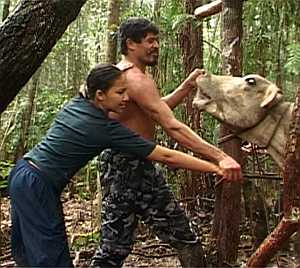 e the film-makers didn’t want to go down that avenue, and since they were out in the jungle, with a group of heavily-armed insurgents, I can hardly blame them for letting that angle slide. Instead, it lets the film speak for itself, and FARC does sometimes come across as little better than kids playing soldiers: one, particularly memorable part of the training, consists of recruits running around, waving wooden guns about and shouting “BANG!” at imaginary opponents. They also have a startlingly bad ‘national anthem’, which sounds more like the fight song from a third-rate community college.
e the film-makers didn’t want to go down that avenue, and since they were out in the jungle, with a group of heavily-armed insurgents, I can hardly blame them for letting that angle slide. Instead, it lets the film speak for itself, and FARC does sometimes come across as little better than kids playing soldiers: one, particularly memorable part of the training, consists of recruits running around, waving wooden guns about and shouting “BANG!” at imaginary opponents. They also have a startlingly bad ‘national anthem’, which sounds more like the fight song from a third-rate community college.
The film’s main weakness is the lack of any real narrative thrust. Now, obviously, in a documentary, this kind of thing is not always possible, but usually there’s a goal or some sense of purpose. Here, events simply unfold, and the vast majority of them are simply not very exciting; the height of drama is an argument about shampoo with another female recruit. There’s not really much of a character arc for Isabel, and despite some impressive cinematography, I can’t really say I learned much about Colombia, FARC or even the heroine. More insight, less documentary, would have been preferred.
Dir: Frank Piasecki Poulsen




